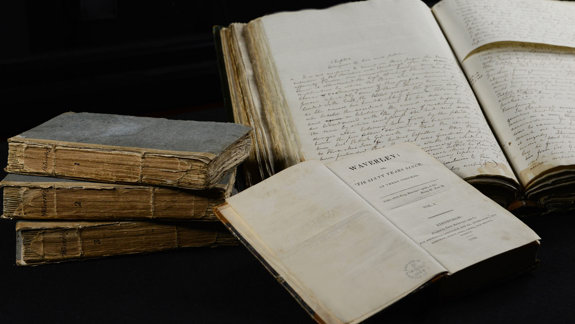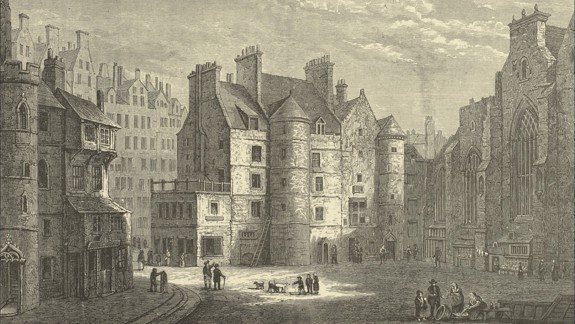Susan Ferrier and her contemporaries: The Scottish novelists who outsold Jane Austen

Introduction
Who was Susan Ferrier?
Born into a well-to-do Edinburgh family in 1782, Susan Ferrier is often described as 'the Scottish Jane Austen'.
Like her more well-known contemporary, Ferrier had a way with words and dialogue. She created equally memorable characters and wrote about the same elite section of society with similar humour and wit. For Ferrier, though, her stories played out not in Bath or Hampshire but in Edinburgh and the Scottish Highlands.

"A truth universally acknowledged…"
Austen and Ferrier's first books ('Sense and Sensibility' in 1811, and 'Marriage' in 1818 respectively) were published just seven years apart. At the time, novels were a fairly new publishing phenomenon. We know Ferrier admired Austen's realistic characters and sharp writing because she discussed Austen's novel 'Emma' with a friend in a letter written in 1816.
"I have been reading Emma, which is excellent; there is no story whatever, and the heroine is no better than other people, but the characters are all so true to life, and the style so piquant, that it does not require the adventitious aids of mystery and adventure."
Letter from Susan Ferrier to Miss Clavering, 1816
Ferrier probably read – or at least knew something about – Austen's other books too. Her second novel, 'The Inheritance' (1824) opens with this eerily familiar first line: "It is a truth, universally acknowledged, that there is no passion so deeply rooted in human nature as that of pride". Jane Austen fans will recognise this as a reworking of the renowned opening line of 'Pride and Prejudice' (1813), "It is a truth universally acknowledged, that a single man in possession of a good fortune, must be in want of a wife."
The novel in the early 19th century
At the time, novels were regarded as a frivolous form of literature, better suited to women. Essays or poetry, which might convey serious thoughts and lofty ideals, were valued far more highly. This is a view Austen herself challenged in the novel 'Northanger Abbey'.
"Although our productions have afforded more extensive and unaffected pleasure than those of any other literary corporation in the world, no species of composition has been so much decried. From pride, ignorance, or fashion, our foes are almost as many as our readers."
Extract from 'Northanger Abbey' by Jane Austen, 1818
'Marriage', 'The Inheritance' and 'Destiny'
Ferrier's first and funniest novel, 'Marriage', tells the tale of a spoilt English heiress raised to do nothing but look beautiful and play with her pug dogs. When she elopes with an impoverished Scotsman, she's forced to adjust to life in a decrepit Highland castle. Unusually, the novel starts where many others end, with a marriage, and goes on to show that marriage doesn't always lead to 'happily ever after'.
We know 'Marriage' was a success because after its publication in 1818, Ferrier's worth skyrocketed. Her brother John sold the copyright of Ferrier's first book to Edinburgh-based publisher Blackwoods for £150. For book number two he secured £1,000.

'The Inheritance' tells the story of a young woman who takes up a position as heiress to a Scottish estate, only to find herself at the centre of a mystery. It's quite a different book to 'Marriage', with a convoluted plot, a secret lurking in the background and a gallery of humorous and eccentric characters.
Ferrier's final novel, 'Destiny', explores the defects of the old Scottish clan system and the harsh realities of modern capitalism. The story follows a Laird whose refusal to enter the modern world has terrible consequences for his estate and his daughter.
Writing in the Scots language
In all her writing, Ferrier wanted to create a believable portrait of the world she had personally experienced. She drew on knowledge she'd gained about Highland life while visiting the Duke of Argyll's estate at Inverary with her lawyer father. And she based some of her characters on real, recognisable people in Edinburgh society. Like the fictional Lady Whistledown in 'Bridgerton', Ferrier's writing sent ladies in drawing rooms around the city into fervent discussions about who was based on who.
This may have been one of the reasons Ferrier chose to publish her work anonymously. However, writing under a pen name wasn't unusual at the time. Jane Austen's books were all published anonymously during her lifetime. There are several possible reasons for this, including the fact that at this time it was not considered appropriate for women to have a public role in their own right. For this reason Ferrier and Austen may not have wanted to draw attention to themselves as the author.
By writing about what she knew, Ferrier ended up creating a distinctively Scottish type of literature. In fact, her inclusion of Scots words and phrases could easily be interpreted as some sort of political or moral move. After all, at the time many leading intellectuals were anxious to rid their speech and writing of 'Scotticisms'. It's more likely, though, that Ferrier simply wanted to reflect the language she heard around her.
Three other Scottish women born around the same time wrote novels that reflect the Scottish landscape, culture, and people too. And each also outsold Austen. They were Elizabeth Hamilton, Mary Brunton and Catherine Sinclair.
Elizabeth Hamilton and 'The Cottagers of Glenburnie'
Elizabeth Hamilton was born in Belfast around 1756. After her father died while she was still a young child, she was sent to live with her aunt and uncle, who owned a farm near Stirling. Hamilton attended a day school from the age of eight, but her formal education ceased in her early teens.

Always a curious and eager reader, Hamilton continued to root out serious books after she left school. She read all the great thinkers of the day and developed a lifelong interest in moral and educational philosophy. An expert and enthusiast on the subject of education, she wrote several respected books about contemporary society. Then, in 1808, she wrote the novel she's best remembered for.
'The Cottagers of Glenburnie' tells the story of Mrs Mason, a retired servant who seeks to improve the lives and morals of her distant relatives in the Scottish Highlands. Though Mason's actions generate plenty of comic moments, the novel makes a serious point about the need for improvement in the Highlands at this time.
Mary Brunton and 'Self Control'
Mary Brunton (born Mary Balfour) was born into a distinguished military family on the Orkney island of Burray in 1778. Brunton's early life could have been something out of a Jane Austen novel itself. Aged 20, she fell in love with the tutor to her younger brothers, Reverend Alexander Brunton, but her family didn't approve. Undeterred, she and Alexander eloped to the mainland by boat.

After they married, the couple moved to Edinburgh, where Alexander became minister at the New Greyfriars Kirk and Mary wrote for her own amusement. Brunton's first novel, 'Self Control', was published in 1811 and was an immediate success.
The novel's main character is Laura, a naive girl who has never set foot outside her remote Scottish village. When Laura's innocence is shattered by a suitor's ugly attempt to seduce her, she embarks on a journey that takes her to Edinburgh, London and the wilds of Canada. Along the way she learns how to survive emotionally and practically in a world where she never completely trusts anyone to look after her.
Brunton's second novel, 'Discipline', appeared in 1814 and was also well received. Unusually for the time, the heroines of both books earn their own money. In 'Self Control', Laura has a job in London, while in 'Discipline', the main character works in Edinburgh.
Catherine Sinclair and 'Modern Accomplishments'
Catherine Sinclair was born in Edinburgh on 17 April 1800, one of 13 children. From the age of 14, she worked as a secretary for her father, the prominent politician Sir John Sinclair.
Taking dictation for long periods each day gave Sinclair a good grounding in the craft of writing. Her first foray into popular writing was 'The Murder Hole'. This horror story was published in 'Blackwood's Magazine', complete with baying bloodhounds on a gloomy, tempestuous night. Sinclair went on to write in multiple genres, including novels, children's literature, travel writing and devotional works.
'Modern Accomplishments', which published in 1836, was Sinclair's first adult novel. The book's main characters, Matilda and Eleanor, are cousins who experience different upbringings. One is brought up by an intellectual mother, the other's raised to be the perfect debutante. Aged 16, the pair arrive in the Edinburgh of the 1830s to complete their educations. Once in the city, they encounter strong opinions about how young ladies ought to behave.

Sinclair's talent for comedy, characterisation and dialogue make this study of teenage girls a lively and engaging read even as the author's own moral agenda shows through. Ultimately the book asks a question that remains relevant today: what does it mean to be an accomplished woman? Is it someone who's well educated? Someone who's clever? Or someone who can make a good show in society? In the sequel, 'Modern society', flirtation is in the air, but questions of money and social status complicate possible romances before they even begin.
Sinclair's novels sold thousands of copies. Her children's book 'Holiday House', which broke tradition by representing children as naturally curious, mischievous and argumentative, remained a nursery favourite for decades.
In contrast to Jane Austen, Susan Ferrier and Mary Brunton, Catherine Sinclair put her name on the title pages of her books. She explained that this was because her father strongly disapproved of anonymous publication.
Why did these writers slip into obscurity?
If all these books are so well-written, why haven't most people heard of them today? Firstly, the body of works that people generally accept as 'great literature' only has room for a certain number of authors. When there's already a well-known and respected woman author from the beginning of the 19th-century (Jane Austen) and an acclaimed Scottish novelist (Walter Scott), it's difficult for a Scottish woman from the same period to find space in this closed club.
Secondly, these women all said uncomfortable things about Scotland. In particular, Susan Ferrier and Elizabeth Hamilton made no secret of aspects of Scottish life they felt worthy of criticism. They thought the feudal system in the Highlands needed reform and that Scottish villagers could do more to improve their lot.
The final reason why these women probably fell into obscurity is because their books were all explicitly religious. They include passages of Christian or moral discussion that were fashionable at the time, but aren't to everyone's taste today.
Which 19th-century Scottish novelist should I read?
If you're after a Scottish take on Austen, read 'Marriage' by Susan Ferrier. If you prefer Dickens, try Ferrier's second book, 'The Inheritance'. Fans of 'Downton Abbey' might enjoy Catherine Sinclair's 'Modern Accomplishments', while anyone looking for stories about independent women should try Mary Brunton's 'Self Control'.
If you're simply after a detailed portrayal of Scottish life at the beginning of the 19th century, then read Elizabeth Hamilton's 'The Cottagers of Glenburnie'. And, if you enjoy any of these books, why not spread the word? Expanding the accepted view of great 19th century literature to embrace more women and more Scots can only be a good thing.
Dive deeper
Literature and poetry

Sir Walter Scott and his historical influences

Mary Shelley and the Scottish Gothic Tradition

